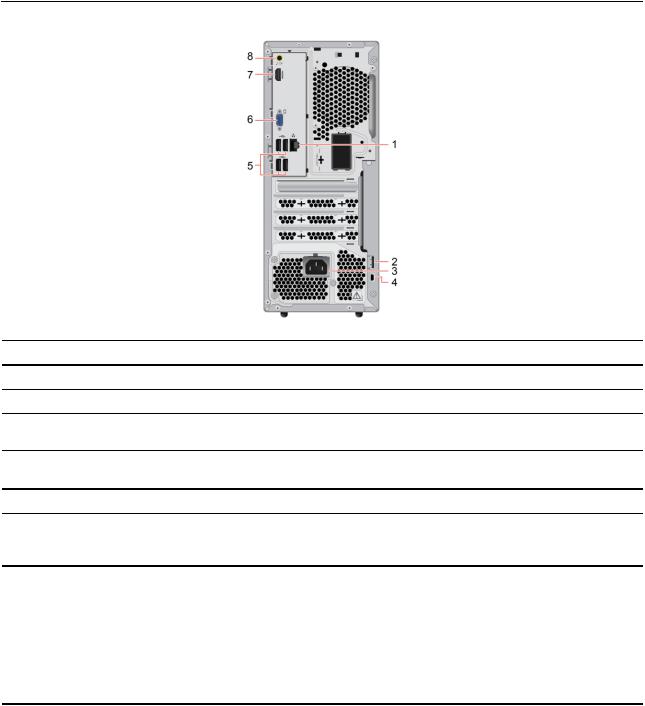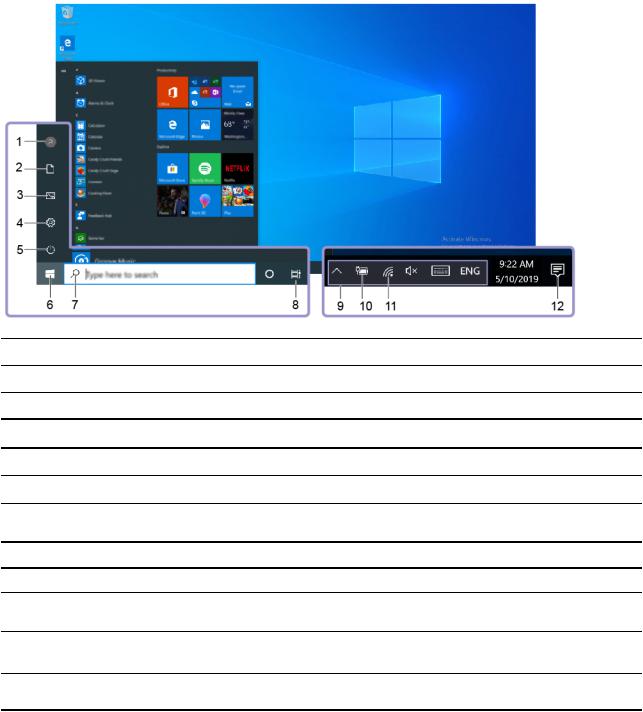Lenovo IdeaCentre 5 14ARE05 90Q30036MH, IdeaCentre 5 14IMB05 90NA006FMH User manual

User Guide
IdeaCentre 5 (14L, 05)
Read this first
Before using this documentation and the product it supports, ensure that you read and understand the following:
•Appendix A “Important safety information” on page 49
•Safety and Warranty Guide
•Setup Guide
First Edition (March 2020)
© Copyright Lenovo 2020.
LIMITED AND RESTRICTED RIGHTS NOTICE: If data or software is delivered pursuant to a General Services Administration “GSA” contract, use, reproduction, or disclosure is subject to restrictions set forth in Contract No. GS- 35F-05925.

Contents
About this documentation . . . . . . . .iii
Chapter 1. Meet your computer . . . . . 1
Front . . . . . . . . . . . . . . . . . . . . 1 Rear . . . . . . . . . . . . . . . . . . . . 3
Features and specifications . . . . . . . . . . . 4 Statement on USB transfer rate . . . . . . . . 4
Chapter 2. Get started with your computer . . . . . . . . . . . . . . . . . 5
Get started with Windows 10 . . . . . . . . . |
. |
5 |
Windows account . . . . . . . . . . . . |
. |
5 |
Windows user interface . . . . . . . . . . |
. |
6 |
Connect to networks . . . . . . . . . . . . . |
. |
7 |
Connect to the wired Ethernet . . . . . . . |
. |
7 |
Connect to Wi-Fi networks (for selected
models) . . . . . . . . . . . . . . . . . 7
Use Lenovo Vantage . . . . . . . . . . |
. . . . 7 |
|||
Use multimedia . . . . . . . . . . . . |
. . |
. |
. |
8 |
Use audio . . . . . . . . . . . . |
. . |
. |
. |
8 |
Chapter 3. Explore your computer |
. . |
. 9 |
|
Manage power . . . . . . . . . . . . . |
. . |
. |
9 |
Set power button behaviors . . . . . . |
. . |
. |
9 |
Set the power plan . . . . . . . . . . |
. . |
. |
9 |
Transfer data . . . . . . . . . . . . . . . . . 9
Connect to a Bluetooth-enabled device. . . . |
. 9 |
Use the optical drive (for selected models) . . |
10 |
Use a media card (for selected models) . . . . 10 |
|
Purchase accessories . . . . . . . . . . . . |
11 |
Chapter 4. Troubleshooting, |
|
diagnostics, and recovery . . . . . . . |
13 |
Basic procedure for resolving computer |
|
problems . . . . . . . . . . . . . . . . . |
13 |
Troubleshooting . . . . . . . . . . . . . . |
13 |
Startup problems . . . . . . . . . . . . |
14 |
Audio problems . . . . . . . . . . . . . |
15 |
Network problems . . . . . . . . . . . . |
15 |
Performance problems . . . . . . . . . . |
18 |
Storage drive problems . . . . . . . . . . |
19 |
CD or DVD problems . . . . . . . . . . . |
19 |
Serial connector problems . . . . . . . . . |
20 |
Software problems . . . . . . . . . . . . |
20 |
Recovery . . . . . . . . . . . . . . . . . |
20 |
Restore system files and settings to an earlier |
|
point . . . . . . . . . . . . . . . . . |
21 |
Restore your files from a backup . . . . . . |
21 |
Reset your computer . . . . . . . . . . . |
21 |
Use advanced options . . . . . . . . . . |
21 |
Windows automatic recovery. . . . . . . . |
21 |
Create and use a recovery USB device . . . . 21 |
|
Update the device driver . . . . . . . . . |
22 |
Chapter 5. CRU replacement . . . . . |
23 |
What are CRUs . . . . . . . . . . . . . . . |
23 |
Replace a CRU . . . . . . . . . . . . . . . |
24 |
Power cord. . . . . . . . . . . . . . . |
24 |
Computer cover . . . . . . . . . . . . . |
25 |
Front bezel . . . . . . . . . . . . . . . |
26 |
Storage drive . . . . . . . . . . . . . . |
28 |
Storage drive bracket. . . . . . . . . . . |
30 |
M.2 solid-state drive . . . . . . . . . . . |
32 |
Power supply assembly . . . . . . . . . . |
34 |
Coin-cell battery. . . . . . . . . . . . . |
35 |
Optical drive . . . . . . . . . . . . . . |
38 |
Heat sink assembly . . . . . . . . . . . |
39 |
PCI-Express card . . . . . . . . . . . . |
40 |
Memory module . . . . . . . . . . . . . |
41 |
Chapter 6. Help and support . . . . . |
45 |
Self-help resources . . . . . . . . . . . . . |
45 |
Call Lenovo . . . . . . . . . . . . . . . . |
46 |
Before you contact Lenovo . . . . . . . . |
46 |
Lenovo Customer Support Center . . . . . . |
46 |
Purchase additional services. . . . . . . . . . |
47 |
Appendix A. Important safety information . . . . . . . . . . . . . . . 49
Appendix B. Accessibility and ergonomic information . . . . . . . . 63
Appendix C. Compliance
information . . . . . . . . . . . . . . . 67
Appendix D. Notices and
trademarks . . . . . . . . . . . . . . . 77
© Copyright Lenovo 2020 |
i |
ii User Guide

About this documentation
•Illustrations in this documentation might look different from your product.
•Depending on the model, some optional accessories, features, and software programs might not be available on your computer.
•Depending on the version of operating systems and programs, some user interface instructions might not be applicable to your computer.
•Documentation content is subject to change without notice. Lenovo makes constant improvements on the documentation of your computer, including this User Guide. To get the latest documentation, go to: https://pcsupport.lenovo.com
•Microsoft® makes periodic feature changes to the Windows® operating system through Windows Update. As a result, some information in this documentation might become outdated. Refer to Microsoft resources for the latest information.
•This documentation applies to the following product models:
Model name |
Machine Types (MT) |
Machine Type (MT) for Energy |
|
|
Star |
IdeaCentre 5 14IMB05 |
90NA, 90NQ |
90NQ |
© Copyright Lenovo 2020 |
iii |
iv User Guide

Chapter 1. Meet your computer
Front
1.Power button
2.Headset connector
3.USB-C™ connector (USB 3.2 Gen 1)
Press to turn on the computer.
To turn off the computer, open the Start menu, click  Power, and then select
Power, and then select
Shut down.
The indicator in the power button shows the system status of your computer.
•On: The computer is on.
•Off: The computer is off or in hibernation mode.
•Blinking: The computer is in sleep mode.
Connect a headset or headphones to your computer.
•Charge USB-C compatible devices with the output voltage and current of 5 V and 3 A.
•Transfer data at USB 3.2 speed, up to 5 Gbps.
•Connect to USB-C accessories to help expand your computer functionality. To purchase USB-C accessories, go to https://www.lenovo.com/accessories.
© Copyright Lenovo 2020 |
1 |

4.USB 3.2 connectors Gen 1 (2)
5.3 in 1 card reader slot*
*for selected models
Connect USB-compatible devices, such as a USB keyboard, USB mouse, USB storage device, or USB printer.
Supported cards:
•Secure Digital (SD) card
•Secure Digital eXtended-Capacity (SDXC) UHS-1 card
•Secure Digital High-Capacity (SDHC) UHS-1 card
2 User Guide

Rear
1.Ethernet connector
2.Padlock loop
3.Power cord connector
4.Security-lock slot
5.USB 2.0 connectors (4)
6.VGA-out connector
7.HDMI™ 1.4 out connector
8. Audio line-out connector
Connect to a local area network (LAN).
Lock the computer cover through a padlock.
Connect the power cord to your computer for power supply.
Lock your computer to a desk, table, or other fixtures through a Kensington-style cable lock.
Connect USB-compatible devices, such as a USB keyboard, USB mouse, USB storage device, or USB printer.
Send video signals from the computer to another video device, such as a monitor.
Send audio and video signals from the computer to another audio or video device, such as a high-performance monitor. For more information, see https:// www.hdmi.org/manufacturer/hdmi_1_4/index.aspx.
Send audio signals from the computer to external devices, such as powered stereo speakers, headphones, or multimedia keyboards. To connect a stereo system or other external recording device, connect a cable between the audio line-in connector of the device and the audio line-out connector of the computer.
Note: If your computer has both an audio line-out connector and a headset or headphone connector, always use the headset or headphone connector for earphones, headphones, or a headset. The headphone connector does not support headset microphones.
Chapter 1. Meet your computer 3

Features and specifications
Hardware configuration
Power supply
Adaptability for power supply
Microprocessor
Memory
Storage device
Expansion
Network features
* for selected models
1.Right-click the Start button to open the Start context menu.
2.Click Device Manager. Type the administrator password or provide confirmation if prompted.
260 W / 310 W / 380 W
•Mainland China: 220 V±22 V, 50 Hz±1 Hz
•Adaptive voltage positioning: 90 V to 264 V, 50/60 Hz
•With voltage selection switch: 90 V to 264 V, 50 Hz±1 Hz
To view the microprocessor information of your computer, right-click the Start button and then click System.
Double data rate 4 (DDR4) dual in-line memory module (DIMM)
To view the storage drive capacity of your computer, right-click the Start button to open the Start context menu and then click Disk Management.
Note: The storage drive capacity indicated by the system is less than the nominal capacity.
•3 in 1 card reader*
•Memory slots
•M.2 solid-state drive slot
•Optical drive*
•Storage drive bay
•Bluetooth
•Ethernet LAN
•Wireless LAN
Statement on USB transfer rate
Depending on many factors such as the processing capability of the host and peripheral devices, file attributes, and other factors related to system configuration and operating environments, the actual transfer rate using the various USB connectors on this device will vary and will be slower than the data rate listed below for each corresponding device.
USB device |
Data rate (Gbit/s) |
3.1 Gen 1/3.2 Gen 1 |
5 |
3.1 Gen 2/3.2 Gen 2 |
10 |
3.2 Gen 2 × 2 |
20 |
4 User Guide

Chapter 2. Get started with your computer
Get started with Windows 10
Learn the basics of Windows 10 and start working with it right away. For more information about Windows 10, see the Windows help information.
Windows account
A user account is required to use the Windows operating system. It can either be a Windows user account or a Microsoft account.
Windows user account
When you start Windows for the first time, you are prompted to create a Windows user account. This first account you created is of the “Administrator” type. With an Administrator account, you can create additional user accounts or change account types by doing the following:
1.Open the Start menu and select Settings Accounts Family & other users.
2.Follow the on-screen instructions.
Microsoft account
You can also log in to the Windows operating system with a Microsoft account.
To create a Microsoft account, go to the Microsoft sign-up page at https://signup.live.com and follow the onscreen instructions.
With a Microsoft account, you can:
•Enjoy one-time signing in if you are using other Microsoft services, such as OneDrive, Skype, and Outlook. com.
•Sync personalized settings across other Windows-based devices.
© Copyright Lenovo 2020 |
5 |

Windows user interface
1.Account 
2.Documents 
3.Pictures 
4.Settings 
5.Power 
6.Start button 
7.Windows Search 
8.Task View 
9.Windows notification area
10.Battery status icon
11.Network icon
12.Action center 
Open the Start menu
• Click the Start button.
Change account settings, lock the computer, or sign out from the current account.
Open the Documents folder, a default folder to save your received files.
Open the Pictures folder, a default folder to save your received pictures.
Launch Settings.
Shut down, restart, or put the computer into sleep mode.
Open the Start menu.
Type what you are looking for in the search box and get search results from your computer and the Web.
Display all opened apps and switch among them.
Display notifications and status of some features.
Display power status and change battery or power settings. When your computer is not connected to ac power, the icon changes to  .
.
Connect to an available wireless network and display the network status. When connected to a wired network, the icon changes to  .
.
Display the latest notifications from apps and provide quick access to some features.
• Press the Windows logo key on the keyboard.
Open the Start context menu
Right-click the Start button.
6 User Guide

Access Control Panel
•Open the Start menu and click Windows System Control Panel.
•Use Windows Search.
Launch an app
•Open the Start menu and select the app you want to launch.
•Use Windows Search.
Connect to networks
Your computer helps you connect to the world through a wired or wireless network.
Connect to the wired Ethernet
Connect your computer to a local network through the Ethernet connector on your computer with an Ethernet cable.
Connect to Wi-Fi networks (for selected models)
1.Click the network icon in the Windows notification area. A list of available wireless networks is displayed.
2.Select a network available for connection. Provide required information, if needed.
Use Lenovo Vantage
The preinstalled Lenovo Vantage is a customized one-stop solution to help you maintain your computer with automated updates and fixes, configure hardware settings, and get personalized support.
Access Lenovo Vantage
Open the Start menu and click Lenovo Vantage. You also can type Lenovo Vantage in the search box.
To download the latest version of Lenovo Vantage, go to Microsoft Store and search by the app name.
Key features
Lenovo Vantage enables you to:
•Know the device status easily and customize device settings.
•Download and install UEFI BIOS, firmware and driver updates to keep your computer up-to-date.
•Monitor your computer health, and secure your computer against outside threats.
•Look up warranty status (online).
•Access User Guide and helpful articles.
Notes:
•The available features vary depending on the computer model.
•Lenovo Vantage makes periodic updates of the features to keep improving your experience with your computer. The description of features might be different from that on your actual user interface.
Chapter 2. Get started with your computer 7

Use multimedia
Use your computer for business or entertainment with the devices (such as a camera, a monitor, or speakers).
Use audio
To enhance the audio experience, connect speakers, headphones, or a headset to the audio connector.
Adjust the volume
1.Click the volume icon in the Windows notification area on the taskbar.
2.Follow the on-screen instructions to adjust the volume. Click the speaker icon to mute the audio.
Change the sound settings
1.Go to Control Panel and view by category.
2.Click Hardware and Sound Sound.
3.Change the settings as you prefer.
8 User Guide

Chapter 3. Explore your computer
Manage power
Use the information in this section to achieve the best balance between performance and power efficiency.
Set power button behaviors
You can define what the power button does according to your preference. For example, by pressing the power button, you can turn off the computer or put the computer to sleep or hibernation mode.
To change what the power button does:
1.Go to Control Panel and view by large icons or small icons.
2.Click Power Options Choose what the power buttons do.
3.Change the settings as you prefer.
Set the power plan
For ENERGY STAR® compliant computers, the following power plan takes effect when your computers have been idle for a specified duration:
Table 1. Default power plan (when plugged into ac power)
•Turn off the display: After 10 minutes
•Put the computer to sleep: After 25 minutes
To awaken the computer from Sleep mode, press any key on your keyboard.
To reset the power plan to achieve the best balance between performance and power saving:
1.Go to Control Panel and view by large icons or small icons.
2.Click Power Options, and then choose or customize a power plan of your preference.
Transfer data
Quickly share your files using the built-in Bluetooth technology among devices with the same features. You also can install a disc or media card to transfer data.
Connect to a Bluetooth-enabled device
You can connect all types of Bluetooth-enabled devices to your computer, such as a keyboard, a mouse, a smartphone, or speakers. To ensure that the connection is successful, place the devices 10 meters (33 feet), at most, from the computer.
1.Turn on Bluetooth on the computer.
a.Open the Start menu, and then click Settings Devices Bluetooth & other devices.
b.Turn on the Bluetooth switch.
2.Click Add Bluetooth or other device Bluetooth.
3.Select a Bluetooth device, and then follow the on-screen instructions.
© Copyright Lenovo 2020 |
9 |
Your Bluetooth device and computer will automatically connect the next time if the two devices are in range of each other with Bluetooth turned on. You can use Bluetooth for data transfer or remote control and communication.
Use the optical drive (for selected models)
If your computer has an optical drive, read the following information.
Know the type of your optical drive
1.Right-click the Start button to open the Start context menu.
2.Click Device Manager. Type the administrator password or provide confirmation, if prompted.
Install or remove a disc
1.With the computer on, press the eject/close button on the optical drive. The tray slides out of the drive.
2.Insert a disc into the tray or remove a disc from the tray, and then press the eject/close button again to close the tray.
Note: If the tray does not slide out of the drive when you press the eject/close button, turn off the computer. Then, insert a straightened paper clip into the emergency-eject hole adjacent to the eject/close button. Use the emergency eject only in an emergency.
Record a disc
1.Insert a recordable disc into the optical drive that supports recording.
2.Do one of the following:
•Open the Start menu, and then click Settings Devices AutoPlay. Select or turn on Use AutoPlay for all media and devices.
•Open Windows Media Player.
•Double-click the ISO file.
3.Follow the on-screen instructions.
Use a media card (for selected models)
If your computer has a SD-card slot, read the following information.
Install a media card
1.Locate the SD-card slot.
2.Ensure that the metal contacts on the card are facing the ones in the SD-card slot. Insert the card firmly into the SD-card slot until it is secured in place.
Remove a media card
Attention: Before removing a media card, eject the card from the Windows operating system first. Otherwise, data on the card might get corrupted or lost.
1.Click the triangular icon in the Windows notification area to show hidden icons. Then, right-click the
Safely Remove Hardware and Eject Media icon.
2.Select the corresponding item to eject the card from the Windows operating system.
3.Press the card and remove it from your computer. Store the card safely for future use.
10 User Guide

Purchase accessories
Lenovo has a number of hardware accessories and upgrades to help expand the capabilities of your computer. Options include memory modules, storage devices, network cards, power adapters, keyboards, mice, and more.
To shop at Lenovo, go to https://www.lenovo.com/accessories.
Chapter 3. Explore your computer 11
12 User Guide

Chapter 4. Troubleshooting, diagnostics, and recovery
This chapter provides solutions to resolve computer problems. Use the basic procedure as a starting point for resolving computer problems.
Basic procedure for resolving computer problems
Prerequisite
Before you start, read Appendix A “Important safety information” on page 49 and print the following instructions.
1.Check that:
a.The cables for all connected devices are connected correctly and securely.
b.All components have been reassembled correctly.
c.All connected devices that require ac power are connected to properly grounded and working electrical outlets.
d.All connected devices are enabled in UEFI BIOS.
2.Use an antivirus program to see if the computer has been infected by a virus. If the program detects a virus, remove the virus.
3.Go to “Troubleshooting” on page 13 and follow the instructions for the type of problem you are experiencing.
4.Recover your operating system. See “Recovery” on page 20.
5.If the problem persists, contact Lenovo. See Chapter 6 “Help and support” on page 45.
Troubleshooting
Use the troubleshooting information to find solutions to problems that have definite symptoms.
© Copyright Lenovo 2020 |
13 |

Startup problems
Problem
The computer does not start up when you press the power button.
The operating system does not start up from the correct storage drive or fails to start up
The computer beeps multiple times before the operating system starts up.
Solution
•Ensure that the power cord is correctly connected to the rear of the computer and to a working electrical outlet.
•If the computer has a secondary power switch on the rear of the computer, ensure that it is switched on.
•The power indicator on the front of the computer is on.
•The computer voltage matches the voltage available at the electrical outlet for your country or region.
•Ensure that all storage drive signal cables and power cables are connected correctly.
•Ensure that the storage drive the computer starts up from is listed as the first startup device in UEFI BIOS.
•In rare cases, the storage drive with the operating system might get corrupted or damaged. In such cases, you might need to replace the storage drive.
•If the computer is installed with an Optane memory:
–Ensure that the Optane memory is not removed.
–Ensure that the Optane memory is not damaged. Check the Optane memory using diagnostic tools.
Ensure that no keys are stuck.
14 User Guide

Audio problems
Problem
The audio cannot be heard on the Windows operating system.
The sound does not come from the headset or headphones.
The sound comes from one of the external speakers.
Solution
•If you are using powered external speakers that have an On/Off control, ensure that:
–The On/Off control is set to the On position.
–The speaker power cable is connected to a properly grounded, functional ac electrical outlet.
•If your external speakers have a volume control, ensure that the volume is not set too low.
•Click the volume icon in the Windows notification area on the taskbar. Check the speaker and volume settings. Do not mute the speaker or set the volume at a very low level.
•If your computer has a front audio panel, ensure that the volume is not set too low.
•Ensure that your external speakers (and headphones, if used) are connected to the correct audio connector on the computer. Most speaker cables are color-coded to match the audio connector.
Note: When external-speaker or headphone cables are connected to the audio connector, the internal speaker, if present, is disabled. In most cases, if an audio adapter is installed in one of the expansion slots, the audio function built into the system board is disabled. Therefore, you must use the audio connectors on the audio adapter.
•Ensure that the program you are running is designed for use in the Microsoft Windows operating system. If the program is designed to run in DOS, the program does not use the Windows sound feature. The program must be configured to use SoundBlaster Pro or SoundBlaster emulation.
•Ensure that the audio device drivers are correctly installed.
Select the headset or headphones as the default audio output device in advanced sound settings.
•Ensure that the speaker cable is inserted completely into the connector on the computer.
•Ensure that the cable that connects the left speaker to the right speaker is securely connected.
•Ensure that the balance settings are set correctly.
1.Right-click the volume icon in the Windows notification area on the taskbar. Then, click Open Volume Mixer and select the desired speaker.
2.Click the speaker icon on top of the volume control, and then click the Levels tab.
Network problems
Note: The Wi-Fi and Bluetooth features are optional.
Chapter 4. Troubleshooting, diagnostics, and recovery 15

Problem
The computer cannot connect to an Ethernet LAN.
When a Gigabit Ethernet model computer is used at a speed of 1000 Mbps, the Ethernet LAN connection fails or errors occur.
The Wake On LAN (WOL) feature does not work.
The Wi-Fi feature does not work.
Solution
•Connect the cable from the Ethernet connector to the RJ45 connector of the hub.
•Enable the Ethernet LAN feature in UEFI BIOS.
•Enable the Ethernet LAN adapter.
1.Go to Control Panel and view by large icons or small icons.
2.Click Network and Sharing Center Change adapter settings.
3.Right-click the Ethernet LAN adapter icon and click Enable.
•Update or reinstall the Ethernet LAN driver.
•Install all networking software that is necessary for your network environment. Check with your LAN administrator for the necessary networking software.
•Set the same duplex for the switch port and the adapter. If you configured the adapter for full duplex, ensure that the switch port is also configured for full duplex. Setting a wrong duplex mode might degrade performance, cause data loss, or result in lost connections.
Connect the network cable to the Ethernet connector using Category 5 wiring and a 100 BASE-T hub/switch (not 100 BASE-X).
Enable the Wake On LAN feature in UEFI BIOS.
•Enable the Wi-Fi feature in UEFI BIOS.
•Enable all Wi-Fi devices.
1.Right-click the Start button to open the Start context menu.
2.Click Device Manager. Type the administrator password or provide confirmation, if prompted.
3.Expand Network adapters to display all network devices.
4.Right-click each Wi-Fi device, and then click Enable device.
•Enable the Wi-Fi feature in Windows Settings.
1.Open the Start menu.
2.Click Settings Network & Internet Wi-Fi.
3.Enable the Wi-Fi feature.
•Update or reinstall the Wi-Fi driver.
16 User Guide

Problem
The Bluetooth feature does not work.
Sound does not come from the Bluetooth headset or headphones.
Solution
•Enable the Bluetooth feature in UEFI BIOS.
•Enable all Bluetooth devices.
1.Right-click the Start button to open the Start context menu.
2.Click Device Manager. Type the administrator password or provide confirmation if prompted.
3.Expand Bluetooth to display all Bluetooth devices. Right-click each Bluetooth device, and then click Enable device.
4.Expand Network adapters to display all network devices. Right-click each Bluetooth device, and then click Enable device.
•Turn on the Bluetooth radio.
1.Open the Start menu.
2.Click Settings Devices Bluetooth & other devices.
3.Turn on the Bluetooth switch to enable the Bluetooth feature.
•Update or reinstall the Bluetooth driver.
Select the Bluetooth headset or headphones as the default audio output device in advanced sound settings.
Chapter 4. Troubleshooting, diagnostics, and recovery 17

Performance problems
Problem
Excessive fragmented files exist on the storage drives.
The free storage drive space is insufficient.
The free memory space is insufficient.
Solution
Note: Depending on the volume of the storage drives and amount of data stored on the storage drives, the disk-defragmentation process might take up to several hours.
1.Close any open programs and windows.
2.Open the Start menu.
3.Click Windows System File Explorer This PC.
4.Right-click your C drive and then click Properties.
5.Click the Tools tab.
6.Click Optimize. Select the drive as desired, and then click
Optimize.
7.Follow the on-screen instructions.
•Clean out your Inbox, Sent Items, and Deleted Items folders from your e-mail application.
•Clean up your C drive.
1.Open the Start menu.
2.Click Windows System File Explorer This PC.
3.Right-click your C drive and then click Properties.
4.Check the amount of free space, and then click Disk Cleanup.
5.A list of unnecessary file categories is displayed. Select the category you want to delete, and then click OK.
•Disable some Windows features or remove some unnecessary programs.
1.Go to Control Panel and view by large icons or small icons.
2.Click Programs and Features.
3.Do one of the following:
–To disable some Windows features, click Turn Windows features on or off. Follow the on-screen instructions.
–To remove some unnecessary programs, select the program you want to remove, and then click Uninstall/ Change or Uninstall.
•Right-click a blank area on the taskbar and open Task Manager. Then, end some tasks you are not performing.
•Install additional memory modules.
18 User Guide

Storage drive problems
Problem |
Solution |
Some or all storage drives are missing from the BIOS menu.
•Ensure that the signal cables and power cables for all the storage drives are connected correctly.
•Ensure that the computer is configured correctly to support the storage drives.
–If the computer is installed with SATA storage drives, ensure that the SATA storage drive enablement module (one to five storage drives) is installed.
–If the computer is installed with SAS storage drives, ensure that the SAS storage drive enablement module (one to five storage drives) or the LSI MegaRAID SAS adapter is installed.
CD or DVD problems
Problem
A CD or DVD does not work.
A bootable recovery medium, such as the Product Recovery CD, cannot be used to start your computer.
A black screen is displayed instead of the DVD video.
A DVD movie does not play.
No audio or only an intermittent audio comes out while a DVD movie is playing.
Solution
•Ensure that the optical drive supports the CD or DVD.
•Ensure that the disc is inserted correctly, with its label up.
•Ensure that the disc you are using is clean. To remove dust or fingerprints, wipe the disc clean with a soft cloth from the center to the outside. Wiping a disc in a circular motion might cause loss of data.
•Ensure that the power cable and signal cable are securely connected to the drive.
•Ensure that the disc you are using is not scratched or damaged. Try inserting another disc that you know works.
•If you have multiple CD or DVD drives installed (or a combination of CD and DVD drives), try inserting the disc into the other drive. In some cases, only one of the drives is connected to the audio subsystem.
Ensure that the CD or DVD drive is set as the top priority of the boot priority order in UEFI BIOS.
Note: On some computer models, the startup sequence is permanently set and cannot be changed.
•Restart the DVD player program.
•Try a lower screen resolution or color depth.
•Close any open files, and then restart the computer.
•Ensure that the disc surface is clean and not scratched.
•Check the disc or package for regional coding. You might need to purchase a disc with coding for the region where you are using the computer.
•Check the volume control settings on the computer and on your speakers.
•Ensure that the disc surface is clean and not scratched.
•Check all cable connections to and from the speakers.
•Use the DVD menu for the video to select a different audio track.
Chapter 4. Troubleshooting, diagnostics, and recovery 19

Problem
The playback is slow or choppy.
A message indicating invalid disc or no disc found is displayed.
Solution
•Disable any background programs, such as AntiVirus or Desktop Themes.
•Ensure that video resolution is less than 1152 x 864 pixels.
•Ensure that the disc is in the drive with the shiny side of the disc facing down.
•Ensure that video resolution is less than 1152 x 864 pixels.
•Ensure that the DVD or CD is inserted into an appropriate optical drive. For example, do not insert a DVD into a CD-only drive.
Serial connector problems
Problem
The serial connector cannot be accessed.
Solution
•Connect the serial cable from the serial connector on the computer to the serial device. If the serial device has its own power cord, connect the power cord to a grounded electrical outlet.
•Turn on the serial device and keep the device online.
•Install any programs supplied with the serial device. Refer to the documentation that comes with the serial device for more information.
•If you added one serial-connector adapter, ensure that the adapter is installed correctly.
Software problems
Problem |
Solution |
Some programs do not work as expected.
1.Check whether the problem is caused by a program.
a.Ensure that the software is compatible with the computer. Refer to the information supplied with the software for more information.
b.Verify that other software works correctly on the computer.
c.Verify that the software you are using works on another computer.
2.If the problem is caused by a program:
• Refer to the printed documentation that comes with the program or the help system of the program.
• Update the program.
• Uninstall the program and then reinstall it. To download a program that is preinstalled on your computer, go to https:// pcsupport.lenovo.com and follow the on-screen instructions.
Recovery
This section introduces the recovery information of the Windows 10 operating system. Ensure that you read and follow the on-screen recovery instructions. The data on your computer might be deleted during the recovery process. To avoid data loss, make a backup copy of all the data that you want to keep.
20 User Guide
